| Reviews & Columns |
|
Reviews DVD TV on DVD Blu-ray 4K UHD International DVDs In Theaters Reviews by Studio Video Games Features Collector Series DVDs Easter Egg Database Interviews DVD Talk Radio Feature Articles Columns Anime Talk DVD Savant Horror DVDs The M.O.D. Squad Art House HD Talk Silent DVD
|
DVD Talk Forum |
|
|
| Resources |
|
DVD Price Search Customer Service #'s RCE Info Links |
|
Columns
|
|
|
Mad Men: Season 2
THE SHOW:
"I'm enjoying the story so far, but I have a feeling it's not going to end well."
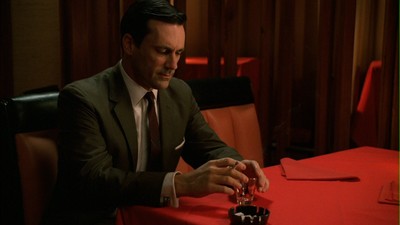
With its second season, Matthew Weiner's Mad Men has at last become the show its biggest supporters have always made it out to be. Don't confuse things, I liked the show's first season, but only begrudgingly as it got on. It took some effort to go along to get along, because I often found it underwritten in terms of characters and overwritten in terms of its depiction of life in 1960. I think the line I often kicked around was that its tongue was shoved so hard into its cheek, it must have bruised. The knowing Far From Heaven "girlfriend please" double entendres of the closeted art director, the endless trotting out of new inventions to gawk at, the winks to the camera with each pop culture reference--it was more That '70s Show than I would have liked.
These problems waned as the season wore on and Mad Men got its sea legs, and they are completely gone in Mad Men: Season 2. The series grows richer, darker, more firmly rooted in its own reality. It's also damn good television, the kind of show you can't turn away from, a pop culture flashpoint that everyone wants to be a part of to such a degree, I am sure somewhere right now, someone who has never seen it is pretending he has just so he doesn't feel left out. "I've got to see that damn show...."
Season 2 jumps ahead a couple of years to 1962. This dispenses with a couple of dangling plot threads--Peggy's baby has been birthed and she's back to work, Duck Phillips is now on staff, and the social change that was barreling down on the Sterling Cooper offices has now fully arrived. One of the writers, Paul Kinsey (Michael Gladis), the fellow with literary aspirations, has grown a goatee and gotten himself an African American girlfriend. Another, Harry Crane (Rich Sommer), is advocating for a TV wing in the agency. Social change, technology, and in between the old and the new is Don Draper, an invented man, a product of the previous age but a perfect candidate to live free in the new one. Which will he choose?
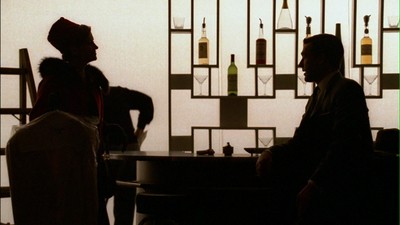
The interesting thing about the Don Draper conundrum is that for as much as progress is alluring to him, he still clings to traditional values. In his work clashes with Duck Phillips (Mark Moses)--a man he helped get hired at the agency, and whose drinking problems will come into play over the course of the season--the fundamental disagreement is over Don's preference for the way things were always done and Duck's urging for Sterling Cooper to go more high risk and pitch for bigger clients. It's a dangerous game, one that could pay off or could toss the men into unknown waters. So, we have the aforementioned TV division, a pair of youth experts brought in to tell the old guard how to appeal to the new generation, and in perhaps the most dramatic example, ditching their long-term small airline client for a much larger one, the onset of new corporate greed introducing the idea of making money out of tragedy.
In the middle of this is Pete Campbell (Vincent Kartheiser), a character annoying by design and played by an actor who is regularly called in to be so (see his run on Angel, for instance). Pete has married into money and is supposed to inherit more, but he's also a man who wants to make something of himself. He's eager to chase Duck into the new frontier, but he's also been chasing Don's approval for the entire series. This psychological failing comes to bear when Pete's father passes away and it turns out he's left his family broke. It's one of several instances where it's discovered that the stalwart men of the previous generation, who are now in charge and still prattle on about WWII, are not as stalwart as they would have us believe. Roger Sterling's marriage crumbles as he chases younger women, including a paid escort and eventually Don's new secretary (you may recall that Roger (the always entertaining John Slattery) dipped into the secretary pool before and had an affair with Joan Holloway, played by the remarkable Christina Hendricks). Bert Cooper (Robert Morse) is growing exceedingly eccentric. Duck is separated from his wife and children. And, of course, there is Don and his many secrets.
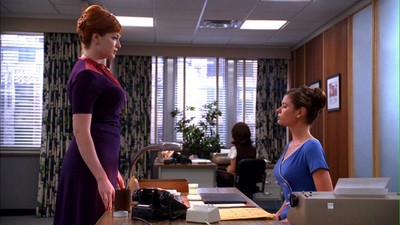
For as much as there is an amazing cast of supporting characters, Mad Men is really Don Draper's show. All the complexities hinted at in Season 1 are now being revealed in Season 2. Though Don loves Betty (January Jones) and their life together, though he longs for stability, his soul is that of a wanderer. As was revealed at the end of the initial season, Don adopted the identity of a man he served with in Korea, and he used the new name to get away from a life that had begun in transience. He isn't exactly rootless, but the roots he does have are self-made and thus tenuous. His eye wanders from Betty to new women. Having lost both of his lovers in Season 1, he now looks at Bobbie (Melinda McGraw), the reckless wife of insult comedian Jimmy Barrett (Patrick Fischler), the pitchman on a potato chip account run by Sterling Cooper. Don is at first attracted to how ballsy Bobbie is. She can play and drink with the best of the boys, and her history of self-invention makes Don see a kindred spirit; that same independence quickly causes the tryst to sour, however, and Don is ready to end it. This has massive repercussions in Don's life.
First, the end of the affair forces Don to face his actions. Jimmy is aware of what has gone on, and he does not believe that Don should be able to walk away clean. More important, though, is when Bobbie reveals that the reputation Don has earned does not entirely match the one he believes himself to have. The broken connections, remaining oblique and avoiding any significant revelations, these things start to add up. For as much as Don has tried to remain aloof, a new being--an untrustworthy, reckless one--has emerged. Bobbie's rejection forces Don to face himself, and it opens up dark, sometimes violent places. This is compounded when Betty kicks him out of the house. A trip to California gives way to a journey toward finding himself, sampling a truly groundless life and also exploring the bridges between his true past and his invented present.
It's going to be interesting to continue to watch Jon Hamm develop as a known actor. His recent stint on 30 Rock played with the idea that he was just a handsome shell without much going on behind it, but Hamm's portrayal of Draper brings the very fine writing to life in complex and fascinating ways. We've been staring into his blank expression for two seasons now, and the longer we look, the more that emerges. The expressions are not blank at all; look close, and you will see subtle images of a man that runs deep. In this way, Jon Hamm, who wasn't a known quantity before Mad Men, is revealing himself as a performer a the same time he reveals more of Don Draper. It's a difficult role, full of tricky maneuvers. Don is not always a nice guy, but we have to always want to watch him and even kind of love him for being bad, the way we previously loved James Gandolfini as Tony Soprano or enjoy Larry David's curmudgeonly rants. Try not to side with Don against Betty. Try not to be a little electrified when Don pushes Bobbie against a wall and threatens her. Try not to smirk when he verbally cuts Pete down. You'll find all these challenges pretty difficult.
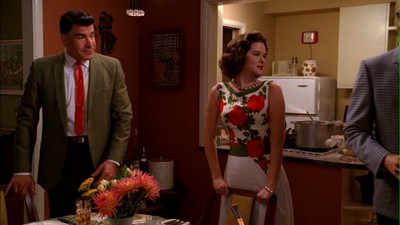
Though Don ends up being the center of attention in terms of the males on Mad Men, the female cast is much more varied and far more integral to the writing than simply being possible love interests for Draper. In real life, the movement for gender equality was starting to foment. We see it in the office with the career efforts of Peggy (Elisabeth Moss) and Joan. Peggy has pushed her way into the boy's club, becoming a copywriter, and as we will discover, had to make the classic sacrifice expected of women throughout time. In order to have more than the cliché, she has to give up the cliché; the baby she was about to have at the end of Season 1 has been taken away from her and given to her sister and mother. Peggy struggles as a single girl, forced to keep quiet when slighted, to accept the attempts to pigeonhole her into only working on women's accounts. She also struggles with the way organized religion perceives her, becoming the focus of a conflicted young priest (Colin Hanks) whose efforts to help her are as much about helping himself.
Joan, a potent force of nature whose position as office manager--what the boys call "head secretary"--has allowed her to control pretty much the entire office, finds her own speed bumps on the road to success. Her failed affair with Roger Sterling is one of a string of failed affairs, and its collapse and Joan's dismissal from Roger's bedroom could be seen as a woman being punished for knowing her own sexual powers. It's like her mother probably warned her, men don't take girls like her home to their own mothers. In Season 2, she is engaged to a doctor, but even he only accepts her as something to possess, to control. When she takes on extra work reading TV scripts to find the right programs to advertise on, he dismisses her ambition as silly. His personal subjugation of Joan takes an even darker turn near the tail end of the season. It's one of the more painful, haunting moments in both seasons, and all the more painful for the sense we get that this is not the first time things have gone so wrong for her. The silent stare, the unspoken pain--Christina Hendricks' performance will break your heart. Again, like Don, Joan is a character whose ruthlessness arguably deserves some comeuppance, but the charisma of the actor woos us to her side; granted, she suffers an extreme punishment no one deserves, but even earlier, when she loses ground in the office to Jane (Peyton List), we'd rather see Jane defeated and Joan victorious.
All the women in the series have to sacrifice things, have to accept compromise or societal punishment. Bobbie works in a man's role, but she has to navigate it in ways men don't, using her sexuality and having to be "the bitch." Note the color scheme in episode 7 when the dangerous Bobbie is decked out in red, placed against Betty, who is dressed in blue, like an armor adorning her façade of tranquility. Betty grows more complicated this season, the responsibility of being Mrs. Draper becoming harder to shoulder. She is afflicted with the boredom of a suburban life, how she is undervalued as a wife, mother, and woman. There is a history to her pain, daddy's little girl now Donny's little girl. Her horse riding gives her an illusion of control, her flirtation with a fellow rider let's her sample the forbidden fruit that Don feasts on, but she never really gets her own back until she lets her anger out. Smash a chair, kick your husband out of the house. Her actions send Don on his next journey into his soul, though the changes come with their own consequences for her. Showing how well planned the writing is over the whole of this episode cycle, Betty's plight connects back to the controversial television program that is so important at the start of the season and the ironic opposite of the personal problem faced by the Campbells, who are having a hard time starting their family.
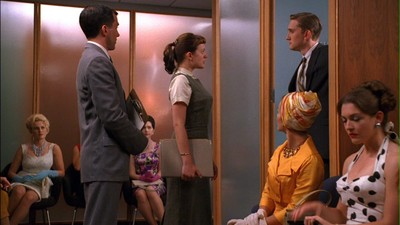
Another aspect of the writing I love is how the writers use the lack of expression from the period, the way it wasn't acceptable to say certain things, to their advantage. Again, when talking about TV and the episode of "The Defenders" that Harry tries to buy time on, the scandal comes from the fact that on that show, they say things outright they aren't supposed to say at all. You can maybe talk about abortion, but not use the word--and not 13 times in 50 minutes, which apparently makes it all the more horrific. This habit of couching the truth in coded language carries over into their personal lives. Everyone dances around their feelings, they do whatever they can to avoid directly saying what is bothering them.
This is a part of the show that has gotten more sophisticated over time. As mentioned, one of my major objections to the early episodes was the character of Salvatore Romano (Bryan Batt), the closeted homosexual art director. Matthew Weiner and his team revealed his sexuality through knowing quips that would have been even too obvious for Paul Lynde. Much better was the later dinner between him and one of Sterling Cooper's clients where the two men navigate their taboo desires without being explicit. That man makes a brief return this season, but more pronounced is Sal's growing attraction to the young writer Ken Cosgrove (Aaron Staton). Though Salvatore's interest is obvious, it's not made so through heavy hammering. Even better, we have no idea if either Ken or Sal's wife (Sarah Drew) are aware. The fact that there is an "out" gay character added this season, one of the pair of Smiths (Edin Gali as Kurt, Patrick Cavanaugh as Smitty) who are freelance ad men hired to inject youth into the company (another old vs. new thematic subplot), adds further comment to the story, suggesting it is becoming possible to speak out loud about such things.
This narrative sophistication is matched by the impressive attention to detail that is put in by the art department. For all the talk of the period objects and the clothes, more should be said about the color design and lighting. Small details, like the burning red in the restaurant when Don goes to a dinner meeting to end the agency's relationship with Mohawk Airlines or the color-coordination in Salvatore's apartment, suggest mood and character nuance in subtle, effective ways. Even the choices of color for clothes, such as the aforementioned contrast between Betty and Bobbie, or the powerful colors that Joan wears when on the attack vs. the less forceful purple, almost like a bruise, that she wears in her darkest scene, effect how we think about who we are watching and what we are witnessing. Notice, too, the warm colors in the California episode as opposed to the regular chilled tones we generally see in New York City.
The show ends with some dangling threads as Don makes his way back from his "lost weekend" and impending changes threaten to shake up the status quo even more. For much of the first two seasons, the characters--and most specifically, Don--have been staving off the consequences of their actions, have been maintaining a lifestyle that can only crash and, as we know, become outdated. It remains to be seen how much of this will catch up with them in Season 3, but if it's anywhere near as involving as this second part of this long, evolving television novel, you can count me in. Mad Men: Season 2 is every bit the triumph we have been lead to believe, it's every bit the triumph the show's creators and fans have always promised, and it's among the best that television has offered in its history as a medium.
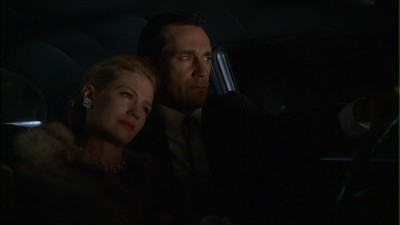
THE DVD
Video:
Mad Men is shot in widescreen and the anamorphic presentation is stellar. The details are rich and sharply rendered. Texture, color, the nuance of light--it's all visible on these digital transfers. These new productions are crisp looking, with no compression problems, scratches, or dirt.
Sound:
All 13 episodes are mixed in Dolby Digital 5.1, and the audio landscape created is fantastic. There is a lot of depth to the soundtrack, balancing the music and the sound effects against the dialogue and moving through all the speakers. Some of the best discs I've heard this year.
Subtitles are available in English and Spanish. There is also Closed Captioning available.
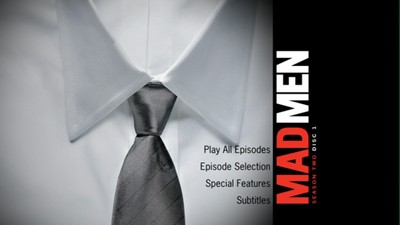
Extras:
Mad Men: Season 2 comes packaged in a well-designed boxed set. The outer packaging has a clear cover that makes it look like a shirt box with a display window--so that we can see the dress-shirt image that adorns the front cover of the interior book. In keeping with the overall thoughtful presentation, this actually ties in with advertising that goes along with this release. A paper insert as well as a rather smart commercial that plays when DVD 1 loads connects the shirt to Clorox bleach, creating synergy that would make Don Draper proud. I never thought I'd suggest anyone watch commercials at the start of the disc, but here I am doing it.
The interior package is a foldable book that features plastic trays for all four DVDs. The book has photos, episode information, and details about special features. The menus on each disc are also designed with grace and a true aesthetic eye, each disc having a unique single image on the main menu that matches up with the image on the disc itself--that man's shirt and a woman's shoe, a glass of Scotch, Joan's neckline, an ashtray and cigarettes.
In terms of bonus content, the producers are thoughtful here, as well, and really give us a lot of extra material that ties in with the show. You may find them overly generous, though, depending on your opinion about audio commentaries. Personally, I think two commentary tracks for each of the 13 episodes here is overkill, and I found it a tedious task to slog through them all. Such a copious helping of explanation leaves no stone unturned in terms of what has gone into the making of Mad Men: Season 2 and what it all means, and really, you need never think for yourself ever again, at least as far as this show is concerned. What happened to mystery? What happened to figuring it out ourselves? Does no one remember the dangers of always peeking behind the curtain? Apparently not, so let's have it all explained!
There is a basic split between the two tracks. The first audio commentary features series creator Matthew Weiner, by himself on episode 3 and joined by someone else on the rest of them (the exception being episode 5, which doesn't feature Weiner at all, and the first commentary is taken over by the director and the writer). Weiner is particularly invested in the show, and so he is able to really get into the nooks and crannies and talk about what is going on. He is of equal quality sharing a rapport with an actor (such as Jon Hamm on episode 2, or Elisabeth Moss on the finale), as he is with other members of the crew. Spending time with post-production team members on episode 12, costume designer Janie Bryant on episode 6 (the "Maidenform" episode), or musical composer David Carbonara on episode 11 offer welcome turns into different territory and help keep his tracks from growing stale.

More help could have maybe been given to the second set of commentaries, which are largely actor populated, but also involve various production team members, such as the writer and/or director of the specific episodes. These tracks work best when actors are chosen for a particular installment based on their importance to the episode, such as the conversation between Rich Sommer, Melinda McGraw, and director Lesli Linka Glatter on episode 3, which features Sommer's character Harry making his bid for the television department and introduces Bobbie Barrett for the first time.
Other actor commentaries, such as episode 10 with Jon Hamm, January Jones, and Vincent Kartheiser, or episode 9 with John Slattery and Joel Murray, don't really go anywhere, proving you can lead a man to a microphone but you can't make him speak. Attempts to shake up the formula often don't even work. A noteworthy blown opportunity is episode 7, where advertising consultant Bob Levinson sits down with Bryan Batt, the actor who plays Salvatore Romano, to go over the episode where Salvatore starts to become involved with Cosgrove and the office becomes obsessed with Cooper's Rothko painting. You'd think that the advertising consultant might shed some light on the innerworkings of the business; yet, when we peek in on a business meeting with the Smiths, Levinson doesn't delve into what they are talking about, instead he enthuses about the painted backdrop.
Your mileage will vary, obviously, depending on how much you like this sort of thing. I am clearly cranky about it, and so pay attention to me as much as you would any crank. For a detailed guide to the commentaries, I can do no better than what my colleague Adam Tyner did in his Blu-Ray review, and so I point you to there. Scroll down to the handy episode-by-episode chart he created. I will second his recommendation of the Robert Morse and Christina Hendricks commentary on the penultimate episode. It's lively and informative. Though, if I were Hendricks, I'd have spent most of it asking Morse about The Loved One.
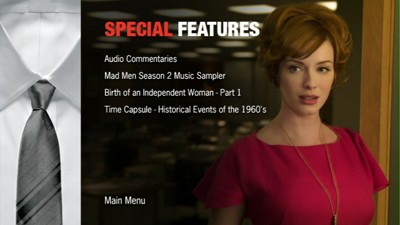
In addition to the flood of commentary tracks, each of the four discs also has a selection of bonus featurettes.
DVD 1 leads with a soundtrack sampler featuring eight short clips from songs used in season 2. The first disc also has the first of a fascinating two-part documentary, "Birth of an Independent Woman" (part 1 is just over 19 minutes on the first disc, part 2 hovers around 22 minutes on DVD 2). This is a detailed exploration of the post-War cultural shift that first saw women return to the home once their husbands returned from combat and the dissatisfaction that lead to the rise of feminism in the 1960s. From Betty Friedan to Sex & the Single Girl, from psychiatric drugs to birth control, the program features social commentators looking at the issues from all sides, including a detour into the concurrent changes in race relations in the U.S. It's heavily illustrated with clips from both seasons of Mad Men that tie the discussion into the story arcs of the various female characters and how their presence in the series reflects these different social aspects.
Equally illuminating is DVD 2's 22-minute "An Era of Style." Narrated by costume designer Janie Bryant and featuring input from several fashion historians, this featurette charts the changes in fashion from the onset of the 1960s to 1963, as reflected in season 2, complete with discussions of the cultural factor that influenced popular looks, including politics, advertising, Jackie Kennedy, and The Man in the Gray Flannel Suit. Alongside show clips and period photographs, we also see a lot of drawings by the show's designers.
Running across all four discs are short pieces listed under the banner "Time Capsule: Historical Events of the 1960s." These miniature documentaries cover topics touched on in episodes of the series, going into depth about things like the TV show "The Defenders" that is at the centerpiece of episode 3 or exploring the famous New York restaurants that Don Draper visits. The restaurant features take us beyond the standard history, and include cooking demonstrations from the chefs at these restaurants. Other topics are approached with the same eye for the unique, and so we take a detailed tour of the redecoration Jackie Kennedy undertook at the White House or talk to the modern hot rod enthusiasts who contribute vehicles to the show. Others, like the segments on the Port Huron Statement and Marilyn Monroe are more standard talking-head pieces. These selections enhance the viewing of Mad Men: Season 2 by showing us how heavily researched and detailed the show really is. The full list of programs is as follows:
* "Jackie Kennedy Tour of the White House" (DVD 1)
* "The Defenders" (DVD 1)
* "Lutece Restaurant" (DVD 2)
* "Sardi's Restaurant" (DVD 2)
* "Maidenform" (DVD 2)
* "The Man Who Shot Liberty Valance" (DVD 2)
* "The Port Huron Statement," a published demand for Democratic change (DVD 3)
* "Mark Rothko" (DVD 3)
* "Marilyn Monroe" (DVD 3)
* "Freedom Riders," the evolution of Civil Rights protests (DVD 4)
* "Space Race" (DVD 4)
* "Hot Rods" (DVD 4)
* "Cuban Missile Crisis" (DVD 4)
By the way, in regards to Marilyn Monroe, there is an episode in Mad Men: Season 2 that has her death as one of its plot points, and I originally thought that the way everyone was reacting was a little exaggerated. Not so now that I've seen the public spectacle made over Michael Jackson.
FINAL THOUGHTS:
DVD Talk Collector Series. I am as skeptical about super-hyped TV shows as the next guy, and I entered Mad Men with a healthy doubt, but whatever concerns might have lingered at the end of the first year, Mad Men: Season 2 has completely erased them. A complex, nourishing drama, Mad Men charts the social upheaval of the 1960s through the changes it effects on the characters. With Jon Hamm's portrayal of Don Draper, a man who is still only beginning to reveal his true depths, Matthew Weiner has found the perfect axis on which the rest of his universe spins. This four-disc boxed set is packed to the gills with extras--some good, some bad--and makes for a truly special package.
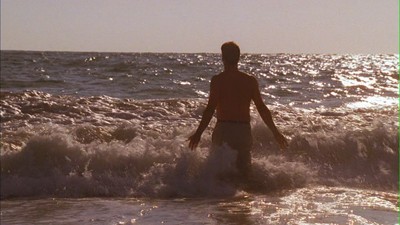
Jamie S. Rich is a novelist and comic book writer. He is best known for his collaborations with Joelle Jones, including the hardboiled crime comic book You Have Killed Me, the challenging romance 12 Reasons Why I Love Her, and the 2007 prose novel Have You Seen the Horizon Lately?, for which Jones did the cover. All three were published by Oni Press. His most recent projects include the futuristic romance A Boy and a Girl with Natalie Nourigat; Archer Coe and the Thousand Natural Shocks, a loopy crime tale drawn by Dan Christensen; and the horror miniseries Madame Frankenstein, a collaboration with Megan Levens. Follow Rich's blog at Confessions123.com.
|
| Popular Reviews |
| Sponsored Links |
|
|
| Sponsored Links |
|
|
| Release List | Reviews | Shop | Newsletter | Forum | DVD Giveaways | Blu-Ray | Advertise |
|
Copyright 2024 DVDTalk.com All Rights Reserved. Legal Info, Privacy Policy, Terms of Use,
Manage Preferences,
Your Privacy Choices | |||||||













